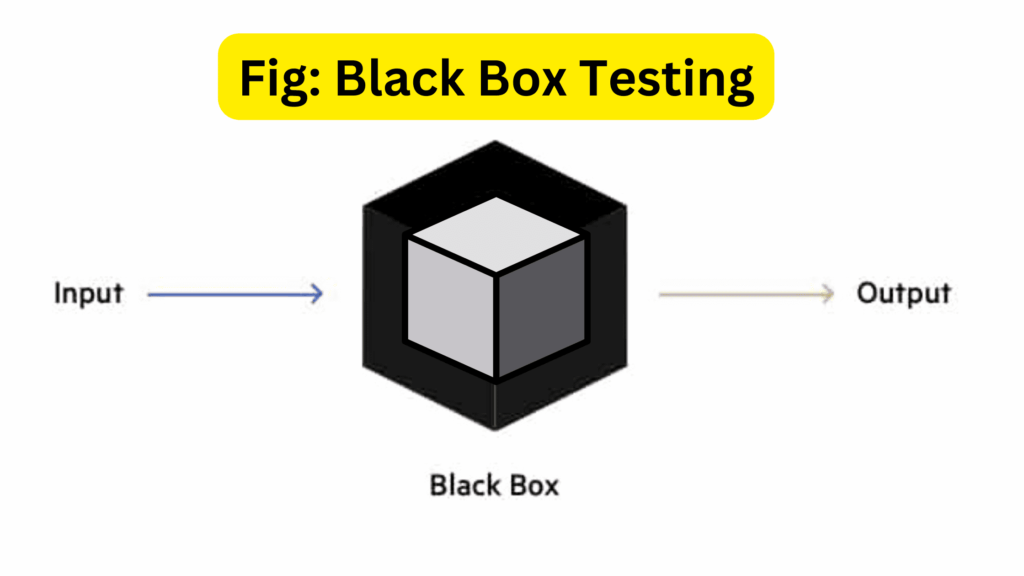Black box testing is a kind of software testing where the person performing the testing (the tester) does not have knowledge of the internal workings of the program and instead tests the functionality of the program.
In other words, “Black box testing is that type of testing where the tester does not need to know anything about the internal workings of the software or how to code.”
Input-output testing is another name for black box testing. Because the software is like a black box to the tester, something he cannot see inside, this type of testing is known as “black box” testing.
This testing only takes into consideration the software’s input and output. As a result, it is also referred to as behavioral testing.
In this test, the tester picks a function and provides it with an input to ensure that it works properly. If the function produces the right result, it passes the testing; otherwise, it fails. Following that, the test team informs the development team of the results and tests the next function. When all of the functionalities are tested and any issues are discovered, they are forwarded to the development team for resolution.

Advantages of Black Box Testing
- User-Oriented: Validates software from the user’s perspective to ensure real-world usability and functioning.
- Requirements Application rate: helps ensure that the program meets the defined criteria.
- Reduced bias: Independent testers can offer an objective assessment of the software’s behavior.
- Early Bug Detection: Identifies usability and functionality concerns early in the development cycle.
- Effective for GUI testing: ideal for evaluating graphical user interfaces (GUIs).
- No programming knowledge is required. Testers do not require a thorough understanding of the software’s internal code.
Disadvantages of black box testing
- Incomplete Coverage: Internal code pathways may not be covered completely, and logic problems may be missed.
- Maintenance Challenges: As needs change, test cases may need to be updated often.
- Internal logic is difficult to test since individual code parts cannot be explicitly tested, making it more difficult to identify internal errors.
- Increased Testing Time: Creating and carrying out detailed test cases can be time-consuming.
How to do black box testing
- First, the specifications and requirements are examined.
- In the second phase, the tester develops a positive test scenario. It picks valid and incorrect input values and evaluates software processing accuracy.
- In the third phase, the tester creates a variety of test cases, including a decision table, an all-pairs test, error estimation, a cause-and-effect graph, and so on.
- In the fourth stage, all of the test cases are run.
- In the fifth phase, the tester checks the predicted and actual output.
- In the last phase, if an error is discovered in the program, it is corrected and tested again.
Techniques of Black Box Testing
Black box testing is a software testing approach in which the tester does not know the program’s internal structure. The tester only understands the program’s functionality and intended behavior. Black box testing is an important element of the software development process because it identifies faults in the program that other testing methods may miss.
- Equivalence Partitioning: This approach divides input values into equivalence classes. An equivalence class is a set of input values that are anticipated to yield the same result. The tester then generates test cases for each equivalence class.
- Boundary Value Analysis: This approach involves testing the program with input values that are on the edge of the predicted range. For example, if a software expects an input value between 1 and 100, the tester might design test cases for 1, 100, 0, and 101.
- State Transition Testing: This approach entails testing software in several states. A state is the software’s status as determined by its input and output. The tester builds test cases to move the program from one state to another.
- Decision Table Testing: In this approach, a decision table is created that contains all of the software’s possible inputs and outputs. The tester then develops test cases for each combination of inputs and outputs.
- Error Guessing approach: This approach includes brainstorming probable software flaws. The tester then builds test cases that attempt to reproduce these issues.
- Exploratory testing is a technique that entails examining the program in search of bugs. Exploratory testing is a creative procedure that does not follow a strict set of standards.
Levels Of Black Box Testing
- Unit testing: Unit testing is essentially a white-box testing approach that examines the internal structure of the code; although, black box techniques can be used at this level. Here, the emphasis is on individual components (functions, modules) as if they were black boxes, verifying their functioning against requirements and expected behavior. This can aid in detecting flaws in the unit’s design or interaction with other units.
- Integration Testing: At the integration testing level, many software modules are merged and tested as one. Black box testing verifies that the integrated modules work together as planned and satisfy the required criteria. Testers supply inputs, examine outputs, and ensure that the interactions between units are functional.
- System Testing: System testing entails testing the complete software system as a single unit. At this stage, black box testing confirms the overall functionality of the system in relation to the system requirements and specifications. It guarantees that the system fulfills the user’s requirements and produces the expected results for a variety of inputs and circumstances.
- Acceptance Testing: Acceptance testing is the final level of testing before the program is released to end users. Black box testing during acceptance testing tries to determine whether the system is acceptable to users and stakeholders based on the agreed-upon acceptance criteria. This might include user acceptance testing (UAT), in which actual users test the system and offer input.
Types of Black Box Testing
1. Functional Testing:
This type of testing determines whether the software’s functionalities perform as planned in accordance with the requirements and specifications. Testers write test cases that span a variety of functionality, giving inputs and verifying outputs for correctness and conformance to intended behavior. Below are some examples of functional testing techniques:
- Equivalence Partitioning is the division of input data into groups (equivalence classes) that are intended to give the same result. Test cases are created for each class.
- Boundary Value Analysis: The program is tested using input values from the edges (boundaries) of the valid input range. This helps to identify possible problems with processing extreme or incorrect inputs.
2. Non-Functional Testing:
Non-functional testing assesses aspects such as performance, usability, security, dependability, and scalability, whereas functional testing concentrates on particular features. These characteristics are critical for providing a positive user experience and ensuring software quality. Below are some instances of non-functional testing:
- Usability Testing: Determines how easy and intuitive the product is to use for the intended audience. This may include user observation or surveys to identify any issues or opportunities for improvement in the user interface or process.
- Performance Testing: Performance testing involves determining how the program operates under different loads and situations. This aids in the identification of bottlenecks or areas for improvement, ensuring that the program functions smoothly under normal usage patterns.
3. Regression Testing:
Regression testing guarantees that current functionalities continue to perform properly following code updates, bug repairs, or new feature implementations. It entails re-running a collection of previously created test cases to ensure that no regressions (unintended feature breaking) have occurred. This is critical to ensuring program stability and preventing regressions from affecting users.
These three methods of black box testing collaborate to thoroughly assess the software’s behavior from a user-centric standpoint. By integrating functional testing with non-functional testing and regression testing, you can verify that the software delivers the intended functionalities, offers a positive user experience, and is dependable throughout its life cycle.
For more informational article, keep an eye on: www.headlineocean.com
